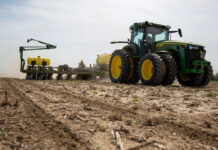The use of precision livestock farming technologies continues to expand past the milking herd. The Dairy Calf and Heifer Association recommends farms maintain a mortality rate below 5% for calves between 24 hours and 60 days of life.
Many dairy farms have calf mortality rates closer to 8%. Technologies that can monitor calf temperature and activity are showing great benefits for earlier disease detection but have challenges that still need overcome.
Monitoring systems
The majority of health monitoring systems are either wearable or indwelling, typically in the rumen or reticulum. The benefit of wearable devices is the ability to reuse these devices and if a device stops working it can easily be replaced with a different device. For calves, the two most common wearable devices are either worn on a collar around the calf’s neck or in their ear as an ear tag.
The collar systems typically monitor the calf’s activity and provide notifications when activity decreases. Some ear tag-based systems build on activity monitoring and offer temperature monitoring of the skin temperature near the tag or from a temperature probe that goes into the ear canal.
These systems can be very sensitive to changes in environmental temperature, and the ear canal probes can be dislodged from the ear canal causing inaccurate readings. When environmental conditions are stable, the additional data from the temperature monitoring system can assist with illness detection.
There are a couple of indwelling systems currently on the market that are small enough to be administered to young calves similarly to giving them a pill. Most of these systems initially only offered temperature monitoring, but as technology continues to improve, they have added activity monitoring, rumination and rumen ph.
From our experience working with indwelling sensors, the greatest challenge is not if the sensor works, but how much battery energy it takes to run the sensor as these systems need to ideally last for the animal’s lifetime.
When working with temperature sensor data, it is important to understand the lag time of the sensor. Even though it is monitoring the calf in real time, that data may not be relayed to your management app every time the sensor takes a reading.
Most sensors take a reading every five to 15 minutes but may not upload the data more than once an hour or less. Also, the sensor is not reading the temperature from the rectum like you normally would when taking a temperature manually. The difference in the region from which the temperature is taken can lead to the numerical difference between what the management system tells you and the temperature you get when manually taking the calf’s temperature.
Research
In a research project, we used the indwelling bolus from the Farmfit system, the bolus read temperature was positively correlated with rectal temperature with the average difference at the time of taking the rectal temperature being less than a tenth of a degree Fahrenheit.
However, at times, the temperature displayed in the management app was two hours old, leading to false differences when first comparing the two temperatures.
Learning to trust the bolus-identified fever can also be challenging. Many of the early identified fevers occurred overnight with the calves cooling off enough by morning to no longer have a rectal fever or bolus-identified fever.
Calves have a natural daily temperature rhythm that varies slightly by season but follows a similar pattern year around. This pattern leads to calves being the warmest in the late evening just before nightfall. They maintain that warmer temperature through part of the night and are at their coolest around sunrise. This daily variation can be over a degree Fahrenheit, causing potential fevers to be masked in the morning due to the calf’s natural overnight cooling.
In our work, we found the temperature monitoring boluses to identify calves with a fever faster than calf caregivers once the calves were weaned. However, the well-trained calf caregivers often found calves on milk before they had a fever.
It is important to remember that not all disease — especially scours — do not always cause a fever. For some diseases, activity monitoring may be a better tool than fever detection.
Sensor-based health monitoring systems bring even more value when calf caregiver turnover is high since they constantly monitor the calves.
The management records system that comes with some of these health monitoring systems brings value to the farm with the ability to establish set protocols for illness treatment and reminders that tell caregivers what to do each feeding.













